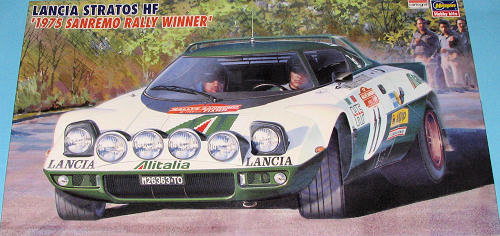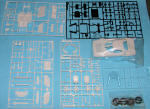
Hasegawa 1/24 Lancia Stratos HF
| KIT #: | 25033 (CR-33) |
| PRICE: | $27.95 MSRP |
| DECALS: | Two options |
| REVIEWER: | Dan |
| NOTES: | 2002 boxing |

| HISTORY |
The Stratos was a very successful rally car during the 1970s and early 1980s. It started a new era in rallying as it was the first car designed from scratch for this kind of competition. The three leading men behind the entire rallying project were Lancia team manager Cesare Fiorio, British racer/engineer Mike Parkes and factory rally driver Sandro Munari.
|
The bodywork was designed by Marcello Gandini, head designer at Bertone, and the technical layout was loosely based on a (Lancia Fulvia V4 powered) concept car called Stratos Zero first shown at the Turin Motor Show in 1970. The body was wedge-shaped, and unusually short and wide, providing maximum traction. In 1971 Lancia presented the Lancia Stratos HF prototype. The Stratos prototype (Chassis 1240) was fluorescent red in colour and featured a distinctive crescent-shaped-wrap-around windshield providing maximum forward visibility with almost no rear visibility (which was unnecessary for rallying anyway). The prototype had three different engines in its early development life: the Lancia Fulvia engine, the Lancia Beta engine and finally the mid-mounted 190 bhp (140 kW) 2418 cc Dino Ferrari V6. |
Lancia did extensive testing with the Stratos and raced the car in several racing events where Group 5 prototypes were allowed during the 1972 and 1973 seasons. Production of the 400 cars required for homologation in Group 4 were launched in 1973 and the car was homologated for the 1974 World Rally Championship. The Dino V6 was phased out in 1974, but 500 engines among the last built were delivered to Lancia.
| THE KIT |
 Hasegawa's kit of this car has been molded in a nice white plastic
with many of the chassis components in black. It comes with a piece of sheet
vinyl or rubber from which one can cut mud flaps. This is a rallye car and
so is a bit more Spartan in its appointments over the road car. As there is
a road car kit, there are several bits and pieces that are not used on this
variant.
Hasegawa's kit of this car has been molded in a nice white plastic
with many of the chassis components in black. It comes with a piece of sheet
vinyl or rubber from which one can cut mud flaps. This is a rallye car and
so is a bit more Spartan in its appointments over the road car. As there is
a road car kit, there are several bits and pieces that are not used on this
variant. Instructions
are typical Hasegawa with Gunze paint references. A most complete decal
sheet is provided with all the green painted areas as decals. If one is good
at decal trimming and placement, it may be worthwhile to use all that green.
Otherwise, painting may be a better option. There are names and numbers for
two cars; the #11 as shown on the box art and the basically identical #1
car, both driven by famous rally drivers Sandro Munari and Bjorn Waldgard.
The decals themselves are superbly printed by Cartograf so no worries about
the wrong shades!
Instructions
are typical Hasegawa with Gunze paint references. A most complete decal
sheet is provided with all the green painted areas as decals. If one is good
at decal trimming and placement, it may be worthwhile to use all that green.
Otherwise, painting may be a better option. There are names and numbers for
two cars; the #11 as shown on the box art and the basically identical #1
car, both driven by famous rally drivers Sandro Munari and Bjorn Waldgard.
The decals themselves are superbly printed by Cartograf so no worries about
the wrong shades!| CONCLUSIONS |
| REFERENCES |
http://en.wikipedia.org
April 2009
If you would like your product reviewed fairly and quickly, please contact me or see other details in the Note to Contributors.
Back to the Previews Index Page